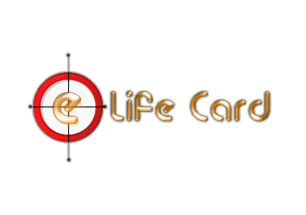 ™
™
 ™
™
eLife Card FAQ’s
1. What is eLife Card?
eLife Card is credit card sized plastic health card designed to provide the user the convenience of having their medical records with them at all times. Designed to provide immediate access to health information that in many cases offers the treating physician insight into important medical history that will improve current and future care offered in the treatment of adults. No longer will patients have to request, pay and wait for their medical records to be sent from one physician to another.
eLife Card manages the collection of medical data through smart chip technology. Thus the medical health card is a “smart card” (ISO 7816). This technology allows and provides the exchange of medical information from one health provider to another and stores the medical information on the card carried by the patient. This is the first line of defense in eliminating medical errors in care and the fulfillment of prescriptions. Up until now, statistics estimate over 98,000 lives are lost each year due to medical errors in handwritten patient information, prescriptions and orders for care. With the use a of a Portable Reader, EMS, Fire and Police can read the card in seconds during a Emergency when seconds count, this give Emergency Responders the information they need to save your life even if you are nonverbal.
Patients now have the security and convenience of carrying their medical information from their primary doctor to their specialist to the pharmacy and hospital in 27 languages.
2. What is a Continuity of Care Record (CCR) or Personal Health Record (PHR)?
The Continuity of Care Record (CCR) is a core data set of the most relevant and timely facts about a patient’s healthcare. It is to be prepared by a practitioner at the conclusion of a healthcare encounter in order to enable the next practitioner to readily access such information. It includes a summary of the patient’s health status (e.g., problems, medications, allergies) and basic information about insurance, advance directives, care documentation, and care plan recommendations. It also includes identifying information and the purpose of the CCR.
The CCR has been developed in response to the need to organize and make transportable a set of basic patient information consisting of the most relevant and timely facts about a patient’s condition. It is intended to foster and improve continuity of patient care, reduce medical errors, improve patient’s roles in managing their health, and assure at least a minimum standard of secure health information transportability.
3. Why should I purchase a Personal Medical Record for me or my family?
Your health information is scattered across many different providers and facilities. Keeping your own complete, updated and easily accessible health record means you can play a more active role in your healthcare. You wouldn’t write checks without keeping a check register. The same level of responsibility makes sense for your healthcare.
A patient’s own PMR offers a different perspective, showing all your health-related information. It can include any information that you think affects your health, including information that your doctor may not have, such as your exercise routines, dietary habits, or glucose levels if you are diabetic.
Also, the PMR is a critical tool that enables you to partner with your providers. It can reduce or eliminate duplicate procedures or processes, which saves healthcare dollars, your time, and the provider’s time. And the information you gather gives you knowledge that assists your preparation for appointments. With your PMR, you can:
4. How does eLife Card help me in a life-threatening emergency?
In cases where consumers are not awake or aware of their medical condition, eLife Card can help. For instance, if in a car accident eLife Card stickers are placed in the member’s back and front windows on the driver’s side identifying “eLife Card”. Also a plastic key fob will be added to the key ring saying “This Person is carrying a eLife Card”. This action will alert the EMS staff to look for the eLife Card in a member’s wallet or handbag. When the eLife Card is collected, it is placed in the reader and instantly the Life-Saving medical information is made available after the Emergency Responder inserts his/her access card and may use PIN/Biometric input for verification. The data available is in compliance with the HIPAA rules and regulations. A full Audit record is used with information of who, when and what was viewed or changed and stored to the card.
5. Does the eLife Card work with any PMS/EMR/EHR/HIS?
The eLife Card is designed to work with any Practice Management (Billing), Electronic Medical Record, Electronic Health Record and Hospital Information System that meets HL7 standards and is XML compatible.
 is a product of
is a product of  ®
®